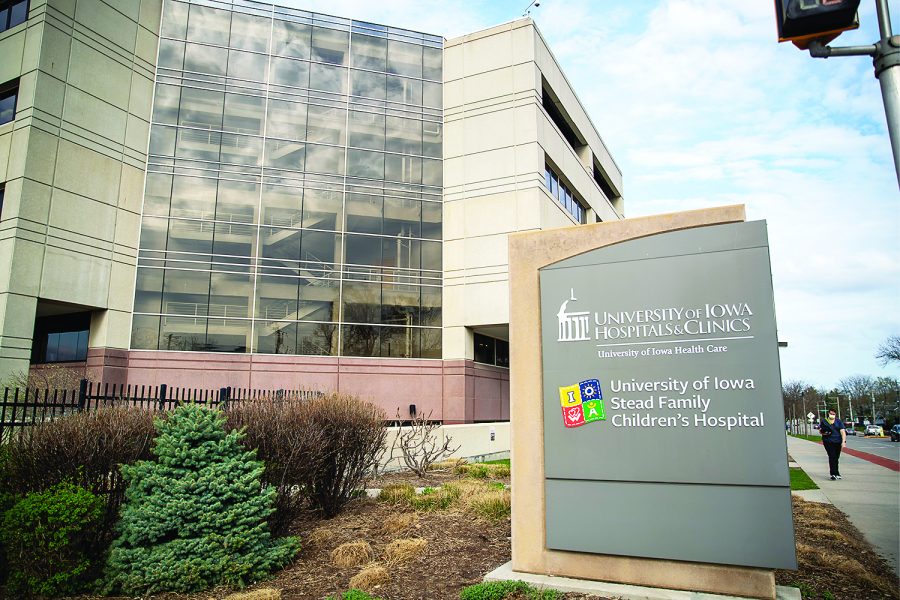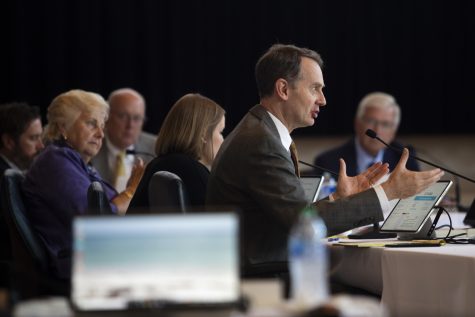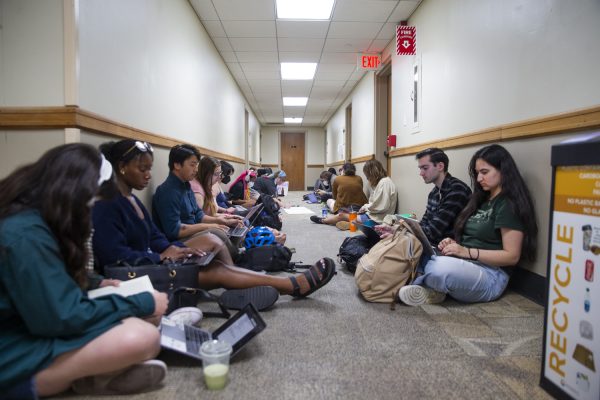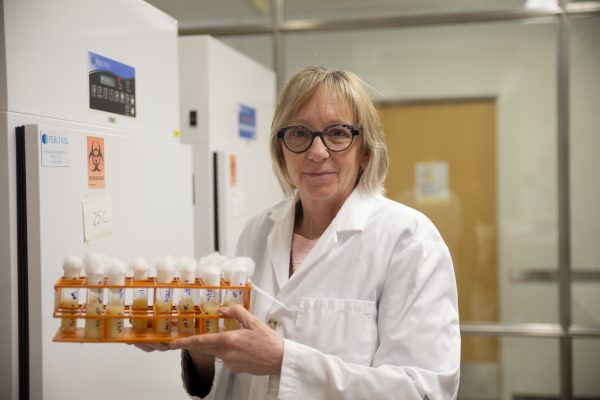UI Hospitals and Clinics see improvements in COVID-19 cases while still struggling with capacity
Representatives from the University of Iowa Hospitals and Clinics outlined the lowering COVID-19 numbers it is seeing, while still facing capacity issues during its presentation to the state Board of Regents on Wednesday.
The UIHC is seen on Wednesday, April 7, 2021.
November 3, 2021
The University of Iowa Hospitals and Clinics is seeing an overall improvement in COVID-19 numbers as it gets ready for the cold and flu season but remains cautious as it still faces capacity issues.
“Both the number of newly recorded COVID-19 cases and the number of hospitalizations due to COVID-19 in Iowa have declined steadily since the high point in mid-September,” said Brooks Jackson, vice president for medical affairs and dean of the Carver College of Medicine, in a state Board of Regents meeting on Wednesday. “As of this morning, the number of COVID patients in our hospital is 19.”
Only 20 UIHC employees are in COVID-19 isolation, and infections are household or community-based as opposed to workplace exposures, he added.
Even with the improving numbers, Jackson reminded the regents to remember that UIHC workers are exhausted and it remains difficult to work in health care.
“Although we are cautiously optimistic about the current trajectory of the pandemic, our team is understandably tired, and we remain focused on workforce preservation,” Jackson said. “The hospital continues to be variable, and as with every sector of the economy, we face challenges in recruiting and retaining workers.”
The UIHC presentation to the regents also had information about its volume and financial highlights, which included:
- An operating margin of 8 percent compared to the goal of 3.7 percent
- Revenues 4.7 percent above budget
- Salary expenses 2.5 percent below budget
- Non-salary expenses 2 percent above budget
Jackson said the vacancy rate is double the amount it was in the fiscal year 2019 report. The agency span, however, has quadrupled since fiscal year 2018, and UIHC is trying to make sure it’s able to maintain staffing.
“This is not unique to us, it’s a challenge the whole industry is experiencing,” Jackson said. “To me, that’s the risk going into this next quarter and the rest of the year. How do we make sure we have the necessary staffing to maintain the volumes and serve the state as we are?”
Suresh Gunasekaran, associate vice president of UI Health Care and CEO of UIHC, told the regents the hospitals and clinics have had to make some difficult decisions.
“We have had to adjust some volumes with some modification [to] OR schedules and closing of operating rooms, not to preserve beds, but because of staffing issues, we have had to modify some of those schedules,” Gunasekaran said.
UIHC cannot sustain higher volumes of patients and is understaffed, but it will continue to try and balance its mission with the challenges it is facing, Gunasekaran said.
“Being understaffed, we’re going to adjust the capacity that we need. The reason we don’t do this very aggressively is that we are a safety net for the entire state,” Gunasekaran said. “If we start shutting down beds, we start shutting down ORs, that is just a longer and longer waiting list of Iowans trying to get in.”
While Gunasekaran said UIHC feels it had a good start to the year, there are still challenges regarding revenue and expense increases. It is currently working on ways to improve the efficiency and effectiveness of the care that it delivers.
It has worked on reducing wait times for cardiology patients by creating more referrals within the UIHC system. To do this, a multidisciplinary leadership group was formed that reviewed the existing system of scheduling appointments and availability, and then made changes including:
- Creating additional appointments for acute patient needs
- Implementing direct scheduling from the Emergency Department to Cardiology Clinic
- Increasing clinical support staff
UIHC saw cardiology clinic availability increase by 30 percent, diagnostic testing availability increase by 51 percent, and the number of new patients seen within 14 days increase by 52 percent. These availability increases caused the hospitals to see visits, testing, and access increases as well.
“I wanted to make sure to highlight this relatively recent success story on how we at UI Health Care continue to be focused on improving our own efficiency,” Gunasekaran said. “We know there are opportunities, and every solution is not building more buildings.”
UIHC also created an Adult Discharge Lounge, where patients are able to wait in between the time their discharge orders are entered and when they are able to leave the hospital.
“These are all medically stable patients that are ready to leave the hospital,” Gunasekaran said. “The impact of having the discharge lounge is it creates capacity. In the hospital, we’re freeing up beds, but that capacity then creates capacity in the emergency room, where the emergency room is backed up waiting for those beds.”
The average patient satisfaction score is 4.94 out of 5 and the lounge has a very promising start, Gunasekaran said.
UIHC also announced in the presentation that it will be expanding the number of trainee positions by 65 trainees in fiscal 2022 that will be fully funded by UI Health Care. It currently provides training support for 821 total residents and fellows.
“The reason we’re doing this is obviously we need more training opportunities for physicians in the state of Iowa,” Gunasekaran said. “We know that UI Health Care is very successful at recruiting and filling these residencies and fellowships, and when folks finish our residencies and fellowships, they’re very positively inclined to practice in the state of Iowa.”















